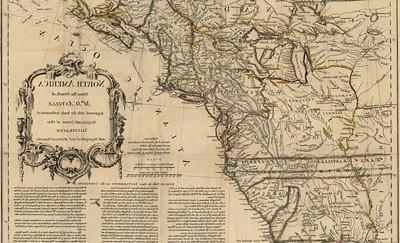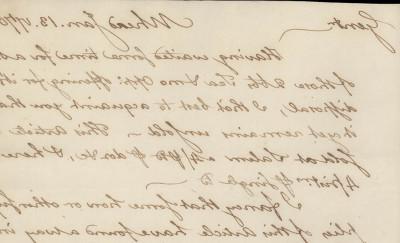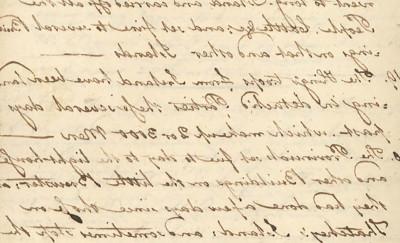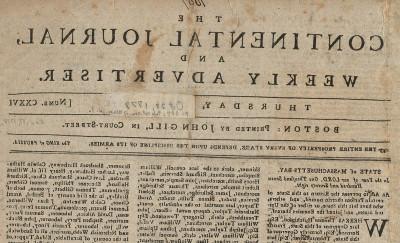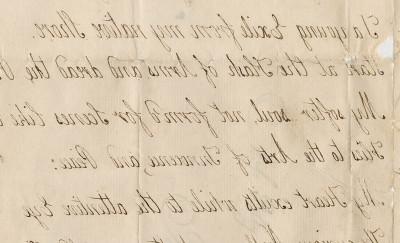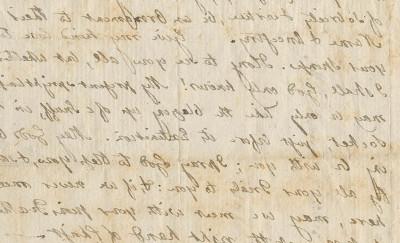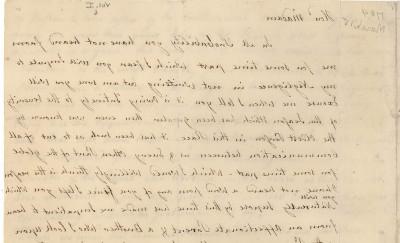Massachusetts Loyalists: Revolution and Exile
Inquiry Question 1: Why did some colonists remain loyal to Britain during the Revolution?
Inquiry Question 2: What consequences did loyal colonists face?
- Background reading for students
-
Choosing Sides in the Revolutionary War: The Loyalists
Before the American Revolution, most British colonists in North America identified as loyal subjects of King George III. Even though tensions were growing between the colonists and the British Parliament, most North American colonists were still respectful of their king.
In 1768, things started to change with the landing of troops in Boston. For years, these men lived in Boston homes and other buildings while serving in the military, becoming part of the community. Things changed in 1774 when Bostonians learned that British troops had seized gunpowder near Charlestown, Massachusetts. In response, 4000 militiamen rushed to Boston ready to fight. A similar instance in Concord, Massachusetts in April 1775, led to hundreds of British troops dead or wounded.
These conflicts, along with the writing of the Declaration of Independence, forced colonists to choose between remaining loyal subjects to the British crown or becoming something new - patriotic Americans. Colonists had to think about family, religion, and occupations before making the difficult choice to remain loyal or not.
Appointed government officials, ministers, merchants, and common folk were some of the people who remained loyal to the crown. Others like farmers, sailors, and laborers did not like the British Parliament, but also did not want to participate in a war. Some colonists believed that the known government of Britain was better than the unknown government of a new America.
Women had little choice in the matter. Married women had to follow their husband’s loyalties, and unmarried women’s choices were made by their fathers or brothers. Some enslaved escaped their owners and served with the British forces, and sometimes offered their freedom. Indigenous people fought on both sides only to be abandoned at the end of the war.
Loyalists faced unique hardships during the war. Their names were printed in newspapers and they were called enemies of the state. Their homes were sometimes taken by state governments and auctioned off to raise money for the war. Some Loyalists were exiled from the colony and made to move to Nova Scotia or return to England.
Some Loyalists fought back and helped the British army to win important victories. Women like Ann Bates and Elizabeth Thompson served as spies for the British troops. Molly Brant, a Mohawk woman who was married to a British leader, helped to establish relationships between the Mohawk people and the British army.
When the war ended in 1783, between 63,000 and 100,000 Loyalists left the United States for other regions in the British Empire. The war ripped families and communities apart. Many of the people who left knew that they would likely not see their loved ones again. Most Loyalist communities were characterized by a feeling of loss.
Source Set
For elementary students, explore the primary sources with these Google slides.
Download full source set (Grades 8-12).
Glossary
Cartographer: A maker of maps
Boycott: A form of protest where people refuse to buy certain things
Imports: Goods brought from one place to another. In this case, items including furniture, clothing, and other goods that came from Britain to the colonies
Neutral: An individual who does not pick sides in a conflict. In this case, a colonist that was neither a Patriot or a Loyalist
Martial Law: A period where military laws, which are normally harsher or more restrictive, replace regular civil laws
Banish: To punish someone by sending them away or forbidding them to return
Exile: An individual who has been forced, either by law or by war, from their homeland
Analyzing Primary Sources
Who created this source?
-
What was this creator’s view of the British Empire in North America?
Who is the audience?
What does this source tell us about why some colonists chose loyalty to Great Britain during the Revolution?
What does this source tell us about how Loyalists experienced the Revolution?
Created by MHS staff, G. Patrick O'Brien, PhD, and Kate Bowen, Elementary Consultant
Our Colonies contain between 900,000 and A Million of English of whom 90 or 100,000 men for defense may be raised [...] The French are intruders into Canada [...] the English claim all North America.
Thomas Jefferys was a London-based illustrator who had never traveled to North America. But when Britain went to war with France in 1754, he hoped to profit from increased interest in the colonies. By copying a map made by a French cartographer, Jeffreys published this map, which became a bestseller and hung in taverns and meetinghouses in Britain and across the colonies.
Citation: Map of North America from the French of Mr. D’Anville Improved with the Back Settlements of Virginia and Course of Ohio Illustrated with Geographical and Historical Remarks, Published by Thomas Jefferys, 1755 (Boston, 1755), Massachusetts Historical Society, http://twod.ngskmc-eis.net/maps/2726.
Shame on him who thinks evil.
The Royal Coat of Arms stood as a sign of King George III’s power throughout the British empire. This Royal Coat of Arms hung in the Provincial House, where the colonial governor lived, and similar displays would have adorned Boston’s courtrooms, along the docks where merchants paid their taxes, and in the barracks that housed British troops. Boston’s colonists would have encountered this symbol often. Governor Thomas Hutchinson even incorporated elements of the Royal Coat of Arms into the decorations he placed on his private home.
Citation: Royal Arms of England, Sign made of wood, paint, gold leaf attributed to Moses Deshon, circa 1750, Massachusetts Historical Society, http://twod.ngskmc-eis.net/database/6497.
I fancy that some how or other supplies of [tea] have found a way into the Town, notwithstanding the Vigilance of our worthy Patriots, who are as assiduous in detecting & removing any trifling package, as if all the Evils of Pandora's Box were inclos'd, or the Fate of Empires depending. The ungenerous Treatment I have met with from them will excuse me if I seem a little warm.
Thomas Robie lived in Marblehead, Massachusetts, where he ran a shop selling goods he imported from Britain. The boycott of British imports greatly hurt his business. In this letter, Robie mocks colonists for refusing to buy British tea and complains about the unfair treatment he has faced. He fled Marblehead as a Loyalist with his family in May 1775 and reopened his business in Halifax, Nova Scotia.
Citation: Letter from Thomas Robie to Richard Clarke & Sons, Letter, 13 January 1770, Massachusetts Historical Society, http://twod.ngskmc-eis.net/database/374.
Martial Law has had full Swing for this month. The Provost with his Band entering houses at his pleasure, stoping Gentlemen from entering their Warehouses and puting some under Guard: and also pulling down Fences, etc.
British troops suffered heavy casualties at the Battle of Bunker Hill in June 1775, and even though they defeated the Patriots, they were not able to break the siege of Boston. William Cheever was a neutral colonist who remained in Boston throughout the siege and recorded the day-to-day activities of soldiers and colonists in his diary until British forces left the city on March 17, 1776. Cheever’s diary entries highlight the disorder, confusion, and hardship faced by those who remained in Boston.
Citation: William Cheever diary page, 1775-1776, Massachusetts Historical Society, http://twod.ngskmc-eis.net/database/1909.
Whereas many dangers may accrue to this state and the United States, if such persons should again reside in this state.
The Massachusetts Legislature passed a law banishing more than 300 Loyalists from the state. The law also aimed at identifying Loyalists from other states and prohibiting them from settling in Massachusetts. Despite being banished, some of these Loyalists returned after the war.
Citation: The Annotated Newspapers of Harbottle Dorr: The Continental Journal and Weekly Advertiser, Vol. 4, Page 1067, 22 October 1778, Massachusetts Historical Society, http://twod.ngskmc-eis.net/dorr/volume/4/sequence/1160.
Read excerpts of Eliza's letter and poem in modern language.
Browse examples of girls’ samplers in the MHS collections.
I a young exile from my native shore.
In March 1776, the Byles family fled Boston with the British army for the safety of Halifax, Nova Scotia. In this letter to her aunts in Boston, eleven-year-old Eliza Byles shows off her penmanship and describes a sampler she stitched, which included a short poem composed by her father.
Citation: Letter from Elizabeth Byles to Polly Byles, 29 September 1778, Massachusetts Historical Society, http://twod.ngskmc-eis.net/database/6502.
Flora sends her Duty to you, and her love to her Child.
In July 1779, eighty-two-year-old Hannah Lee wrote this letter to her Loyalist granddaughter, who had been forced to flee Marblehead, Massachusetts for the safety of Halifax, Nova Scotia at the start of the war four years earlier. Lee described the changes the war had brought to their former home, paying special attention to the newfound status of Flora, a woman she enslaved. Lee also conveyed a short note from Flora to her daughter, who Lee’s family had taken with them to Nova Scotia.
Citation: Letter from Hannah Lee to Mary Bradstreet Robie, 26 July 1779, Massachusetts Historical Society, http://twod.ngskmc-eis.net/database/6501.
Read an excerpt from Mary's letter to her mother.
Read a short, modified excerpt where Mary discusses her young children's experience of life in exile.
I am Determind to Indulge the Pleasing Idea that we Shall not always be at this Unhappy Distance from Each other.
Although the Treaty of Paris officially granted American independence and ended the Revolution in 1783, many Loyalist families remained separated from loved ones. Mary Badger had fled Boston with other loyalists in March 1776. In this 1784 letter, Badger writes from Newport, Rhode Island to her mother in Haverhill, Massachusetts describing the devastation brought by the war and her hope that they might be reunited in the future.
Citation: Letter from Mary Cooke Badger to Mary Cooke Saltonstall Harrod, 15 March 1784, Massachusetts Historical Society, http://twod.ngskmc-eis.net/database/2085.
For Teachers
Massachusetts Loyalists: Revolution and Exile
Background Reading
- Additional Context for Teachers
-
On the eve of the American Revolution, the British colonists of North America were not passionate revolutionaries destined to fight for independence. To the contrary, most possessed a devout love of their distinctly British liberties and identified as loyal subjects of King George III. The removal of French power from mainland North America after the French and Indian War in 1763 had caused a surge of British patriotism among colonists from Georgia to Massachusetts. “By an amazing series of victories, and by the wisdom of our King,” one Massachusetts minister preached, “hath given us the just, undisputed, and peaceful possession of a territory, whose value and extent we are not able to estimate.” The gracious colonists of New York City voted in 1766, even amid growing tensions between colonists and the British Parliament, to commission a statue of the King in honor of “the innumerable and singular Benefits received from our most gracious sovereign.” Even when the First Continental Congress petitioned the King to address some of their grievances in October 1774, the colonial delegates were careful to remind the King that they were his “faithful subjects […] filled with sentiments of duty to your majesty and affection to the parent state.”
But at the same time that delegates in Philadelphia were petitioning the King for change in colonial policy, more rebellious colonists were preparing for conflict. In 1772, Bostonians had organized the first committee of correspondence to facilitate a speedy response to hostile British action. When correspondents spread the news that British troops from Boston had seized gunpowder from a storage location in nearby Charlestown, Massachusetts in early September 1774, 4,000 militiamen from across New England rushed toward the city ready to fight only to find the munitions already seized and troops returned to Boston. On the night of April 18, 1775, news of a similar mission to Concord, Massachusetts spread through the countryside. By the following evening, hundreds of British troops lay dead or wounded.
Armed conflict in the spring of 1775 and the Declaration of Independence the following summer forced colonists to choose between remaining loyal subjects and becoming something new: patriotic Americans. Many states tried forcing elected officials and male citizens to renounce their fidelity to the King; however, these oaths of allegiance were never evenly administered or regulated, leaving historians to debate exactly how many colonists remained loyal. One study suggests that of the about 2.59 million free people who lived in the colonies when the war ended in 1783, a little less than twenty percent, or about 513,000 colonists, were loyal. An even larger group, somewhere between thirty-five and forty percent of colonists, attempted to remain neutral, with varying levels of success. It is important to remember that much like people today, revolutionary allegiances did not always fit neatly into one camp or the other. Instead, colonists had to weigh competing loyalties, including those to family, religion, occupation, etc., and make difficult choices that often changed over time.
Those who remained loyal came from a variety of backgrounds and chose loyalty for many reasons. Patriots mocked loyal colonists by calling them “Tories,” a title meant to emphasize their devotion to the King. Unsurprisingly, many appointed officials, whose power came from the King, did remain loyal as did many Anglican ministers who recognized the King as the head of the church. Many wealthy merchants, with ties to the British-controlled Atlantic economy, also chose loyalty. But so too did common people. Like their Patriot counterparts, many loyal farmers, ropemakers, sailors, and laborers shared a dislike for British colonial policy, but opposed the idea of armed revolution. Many believed that the Patriots were being misled by a few demagogues who simply wanted to seize power from the British for themselves. Others simply believed that the devil they knew in the British was better than the devil they did not in the new American government.
Identifying the loyalties and allegiances of women, free and enslaved people of color, and Native Americans is even more challenging. Both law and practice barred most women from declaring their own allegiances. Unmarried women were “covered” by the loyalties of their fathers or brothers, while married women assumed their husband’s loyalties. But not all women passively accepted their husband’s allegiance as the case of Grace Growden Galloway, a Philadelphia woman who attempted to protect her property despite her husband’s British sympathies, demonstrates. When the Governor of Virginia offered freedom to enslaved people who escaped their rebellious enslavers and served among British forces, thousands, including many people enslaved by Thomas Jefferson, ran away to British lines. Believing the British would protect them, more than 3,000 people of African ancestry left New York City with the British in 1783 only to find themselves re-enslaved or living in poverty in British Canada. Loyal colonists who fled to the Caribbean also forced the people they enslaved to flee with them. Native Americans fought on the American and the British side only to find themselves abandoned by both at the end of the war.
Loyal colonists faced many hardships during the war. Patriot newspapers printed the names of colonists who did not support the Patriot cause and labeled them enemies of the state. Massachusetts colonists who had expressed support for the former governor Thomas Hutchinson were forced to make embarrassing public recantations. In the days after the Battles of Lexington and Concord in April 1775, thousands of loyal colonists, seeking the protection of the British army, flooded into Boston, where they would remain until the army evacuated for Nova Scotia on March 17, 1776. State governments seized loyal colonists’ homes, including those of wealthy colonists like Cambridge, Massachusetts’ Penelope Vassall, often auctioning them to the highest bidder to raise money for the war effort. Others suspected of British sympathies faced violence and imprisonment.
But people loyal to Britain also fought back. In February 1776, an army of loyal colonists in North Carolina fought Patriot militiamen at the Battle of Moore’s Creek Bridge. Loyal colonists in the South Carolina Backcountry not only harassed their Patriot neighbors, they also helped the British army win important victories at the Battles of Camden and Waxhaws in the Spring of 1780. Loyal women like Ann Bates of Philadelphia and Charleston’s Elizabeth Thompson served as spies, relaying important information about troop movement and supplies to British leadership. Konwatsi'tsiaienni, more commonly by her English name, Molly Brandt, played a critical role in establishing and maintaining the alliance between the Mohawk people and the British army.
When the war ended in 1783, between 63,000 and 100,000 colonists left the United States for other regions of the British Empire. Roughly half of those who fled resettled in British Canada, especially in the colonies of Nova Scotia, New Brunswick, and Upper Canada, which would later become Ontario. In 1792, around 1,200 Black settlers of Nova Scotia left to found the Freetown Colony in Sierra Leone. Another large group of refugees settled in the British Isles, while others relocated to the Caribbean. The leaders of these refugees adopted a new name for themselves: “Loyalists,” which they hoped would bolster their claims for financial compensation from the British government by giving them the appearance of a unified body of loyal subjects. But this title failed to capture the widespread suffering these refugees endured. The war had torn many families apart, and those who fled left friends and family knowing that they would probably never see them again. Although the refugees wanted to be known for their loyalty, most Loyalist communities were defined by a feeling of collective loss.
In the years following the American Revolution, most of the loyal colonists who remained in the United States were reintegrated back into American society. There are even examples of Loyalist families who fled being allowed to return, including a few that had been banished by law. As one returning Massachusetts loyalist wrote upon her return in the late 1780s, “Former animosities were all forgot.”
Works Cited
Museum of the American Revolution, “Season of Independence, Big Idea 1: The British Empire on the Eve of America Independence.”
What Happened to British Loyalists After The Revolutionary War: NPR (Rachel Martin, host, and Professor Maya Jasanoff).
Kacy Tillman, “What is a Female Loyalist?,” Commonplace: The Journal of Early American Life, Summer 2013.
Nova Scotia Archives, “Black Loyalists, 1783-1792.”
Close Reading Questions
- Source 1: Thomas Jefferys’ Map of North America, 1755
-
- We know cartographers create maps to help people navigate. But the British government also paid eighteenth-century mapmakers to create maps that would be sold to common people and would introduce them to the idea of the British Empire. What details of Thomas Jefferys’ map might have helped the average person understand the size and importance of the British Empire in North America?
- Why does Jefferys draw the viewer’s attention to the number of French and English colonists living in North America?
- How do you imagine Native Americans might have responded to Jefferys’ map, especially the accompanying statement that “the French are intruders into Canada?”
- Imagine you were a British colonist living in North America when this map was published in 1755. Do you agree with Jeffreys’ assertion that “the French are intruders into Canada?” Explain.
- Compare Jefferys’ map with this map of North America made by Henry Popple. In what ways are the maps similar? In what ways are they different? How do these maps help us understand why colonists celebrated being British in the years leading up to the American Revolution?
- Source 2: The Royal Arms of Great Britain (1714-1801)
-
- What symbols appear on the Royal Arms and what are these symbols meant to represent?
- The Royal Arms contains two mottos: “Shame on him who thinks evil” and “God and my right.” What is the purpose of these messages? How would colonists understand these messages?
- Examine this artist’s depiction of the Old Province House. Can you find where the Royal Arms would have been displayed? Why would it have been placed in this location?
- Examine this decorative pilaster from Governor Thomas Hutchinson’s private residence. Do you see any similarities between it and the Royal Arms? Why would someone like Hutchinson want other colonists to know his relation to the government? How do you think this colonists reacted to someone like Hutchinson’s
- Source 3: Merchant Thomas Robie Questions American Boycotts, 1770
-
- According to Thomas Robie, how has the boycott of British tea affected his business?
- Does Robie believe the boycotting of tea is necessary or effective?
- What is Robie’s opinion of those who support the boycott of tea? Why does he feel this way?
- How does this letter help us understand the Loyalist view of colonial protest and the coming of the American Revolution?
- Source 4: William Cheever Describes the Siege of Boston in his Diary, July 1 to 21, 1775
-
- What events does William Cheever record happening in Boston between July 1 and July 21, 1775?
- In describing the events of July 1775, does Cheever ever mention Patriots or Loyalists? What do you think this says about his loyalties during the war?
- What do the events Cheever recorded in his diary tell us about what life was like in Boston as it was besieged by Patriot forces in July 1775?
- Source 5: Loyalists are Named in the Massachusetts Banishment Act of 1778
-
- What do the occupations of Loyalists named in the Massachusetts Banishment Act suggest about the backgrounds of Loyalists in Massachusetts?
- What evidence is brought against the named Loyalists and why did the Massachusetts legislature believe it necessary to banish the Loyalists named in the Act?
- What does the Massachusetts Banishment Act of 1778 show us about how suspected Loyalists in Massachusetts were treated?
- Source 6: Eliza Byles Describes Exile in a Letter to her Aunts, 29 September 1778
-
- What is Eliza Byles hoping to accomplish in this letter to her Aunts? What elements of her letter demonstrate how she hopes to achieve this objective?
- What does Byles’ letter show us about how the American Revolution affected families?
- Compare this sketch of Byles’ new home of Halifax, Nova Scotia to this sketch of her old home in Boston. Do the two towns appear more similar or different? How might this comparison help us understand why Loyalists living in Nova Scotia considered themselves “exiles”?
- Source 7: An Enslaved Family is Torn Apart by Loyalist Resettlement, 26 July 1779
-
- Towards the end of her letter, Hannah Lee writes, “I long to see you all, but whether I shal, God only knows!” Why is Lee unsure if she’ll see her family again?
- How had the war changed everyday life in Marblehead, Massachusetts for Flora, the woman Lee enslaved? How does Lee feel about these changes?
- Where does Flora’s voice appear in Lee’s letter and what does it tell us about how African American families experienced the American Revolution?
- Source 8: Mary Badger Hopes to See her Mother Again, 15 March 1784
-
- According to Mary Badger, how had the Revolution affected the town of Newport, Rhode Island?
- How had the Revolution affected Badger’s relationship with her mother?
- What is Badger’s tone toward her mother? What does Badger’s letter show us about how Loyalist families continued to face hardship even after the war was over?
Suggested Activities: Elementary
- Loyalist Close Reading
-
Materials:
Loyalist Close Reading – vocabulary supports
Loyalist Close Reading – text dependent questions
Teacher Directions:
Introduce the topic of Loyalists to students through a Close Reading Activity (without content vocabulary support) or a Close Reading Activity (with content vocabulary support).
As a reinforcement exercise, review the information using a Text Dependent Activity which can be completed over the course of a few days.
- Analyzing Primary Sources
-
Materials:
Choosing Sides in Revolutionary Massachusetts – Google Slides
Context and Teacher Directions
Activity Overview:
After students have completed the close reading activity, introduce the infographic, “Who Lived in Boston in the 1760s to the 1780s?” so students can understand the demographics of Boston before the troops arrived in 1768.
The remainder of the Set includes a variety of sources - maps, buildings, diary entries, government documents, and letters - each designed to illustrate the circumstances in Boston (and the surrounding areas) and the consequences for those who remained loyal to the British crown. The sources are designed to be used as a set, but can also be used individually due to grade level of students and/or time constraints.
For each source, read the Context section on the Source page together. Then ask students to complete the For the Student section, using the prompts as discussion frames. Teachers may also choose to do deeper dives into some of the sources; each slide in the slide deck has a linked google doc available for this purpose.
- Analyzing Images: What did British power look like in 1760s Massachusetts?
-
Materials:
Column from Governor Hutchinson's mansion
- Thomas Hutchinson, whose family had been in Massachusetts for over 140 years, was lieutenant governor from 1758-1771 and governor from 1771-1774. During Stamp Act protests in 1765, a mob ransacked his mansion. The stone columns on the outside of his house featured a carving of the king.
The Hutchinson House | Historic New England
The Boston Evening-Post, 25 November 1765
- Students can read the header of this newspaper (underneath the title) "The united voice of all His Majesty's free and loyal subjects in America; Liberty and Property and No Stamps"
- The military arrived in Boston in the fall of 1768 to protect customs officials tasked with collecting taxes. Some people welcomed this show of British strength; the Sons of Liberty worried about having a standing army stationed in their city during peacetime.
Context: Following the end of the Seven Years' War, Great Britain was a large empire, and North American colonists were proud to be part of it. However, following unpopular tax policies like the Stamp Act (1765) and the Townshend Acts (1767), protests began to ring out in Boston. With the arrival of the British army in the fall of 1768, tensions really began to rise. Nonetheless, nobody imagined the American colonies were just a few years from declaring independence.
Activity Overview: What did British power look like in 1760s Massachusetts? Students look at a variety of images, symbols, and phrases to answer this question. It's an opportunity for students to remember that all colonists began as Loyalists!
For each image, students can do a 3-2-1 (as a class, in partners, or individually):
- 3 things I notice
- 2 things I notice when I look closer
- 1 question I have about this source
- Creating Dialogue: A Massachusetts Dinner Party
-
Materials:
- Revolutionary Era timeline
- Revolutionary Era biography cards: Loyalists, Neutrals, and Patriots
- Dinner Party Instructions (Google slides)
- Dinner Party printed template
- Sentence Starter cards
Activity Overview: In groups, students choose 4 of the Revolutionary Era biography cards to place around a dinner table together. There are ~30 biography cards total, and include a diverse range of Patriots, Loyalists, and political neutrals. After reading about the person on their biography cards, students ask each other questions (in the past tense!) about their historical figure's point of view during the Revolutionary War. Which side did they support, and why? In what ways did they agree/disagree with the other people around the table? Students can use the sentence starter cards to get started, or can write their own questions.
- Creating Found Poetry from Primary Sources
-
Materials:
- Eliza Byles' 1778 letter to her aunts (simplified excerpt)
- Girls' Samplers, 1700s and 1800s
- Found Poetry: Teacher Directions and Student Handouts
Context: What can students learn about girls and their education in the late 1700s and early 1800s? At that time, young, wealthy girls learned to stitch samplers as part of their education. Through samplers, they practiced their letters and artwork, learned practical skills like sewing and spinning, and demonstrated their commitment to good moral standards.
When the Loyalist Byles family went into exile in Halifax, Canada, 11-year-old Eliza Byles began her education. She wrote her aunts in Boston a letter, and at the end, shared with them a poem her father had written for her to stitch into her sampler, that described her life in exile. Although we don't know what Eliza's sampler looked like, other girls' samplers in the MHS collections give us a good idea.
Activity Overview: Students read a modified excerpt of Eliza's letter and the poem she stitched in her sampler. Then, they spend time looking at 5 other girls' samplers to get a sense of what samplers had in common. They then choose 3 primary sources from among the letter and samplers, out of which they create a found poem based on a theme of their own choosing. They can draw a border around their poem, and illustrate it to create their own, 21st century sampler.
Extension/Alternative: This activity focuses more on what late 18th century education looked like for girls, and what values they were taught, than on the experiences of children in exile during the Revolutionary War. To focus more on children's experiences in exile, pair Eliza's letter with a modified excerpt of a 1784 letter from Mary Badger to her mother, in which she describes her children's life in exile in Rhode Island.
Suggested Activities: High School
- Analyzing Loyalist Letters, 1778-1784
-
Materials:
Context: Between April 1775 and the early months of 1784, between 63,000 and 100,000 Loyalists fled the rebellious states. Some of these people believed the British Empire superior to the young United States. Others believed fleeing was the only way to ensure their family’s safety. People who were enslaved to fleeing Loyalists had no choice. While the causes differed, the flight of the Loyalists separated many families. Many would never be reunited. For the families torn apart by the Revolution, their only means of staying in contact was through letter writing.
Activity Overview: Students work independently to read and analyze letters between Loyalist family members separated by the war to better understand how Loyalists experienced the Revolution, and what they thought of their own circumstances.
- Anticipation Guide
-
Anticipation Guide: Power and Allegiance in the Revolutionary Era
Time: 2 Class Periods
Context: Today, many students believe that the colonists of North America had always considered themselves “American” and that independence from the British Empire was somehow inevitable. Such an understanding suggests that students see the Loyalists as the group of colonists who switched their allegiance, when in reality it was the newly created “Patriot” identity that signaled a change. This activity, which is divided into three components, is designed to introduce students to the idea of British loyalism in North America. It challenges students to confront their assumptions, think critically about power relations between Great Britain and the colonies through the analysis of primary sources, and grapple with the pros and cons of loyalty to the British Empire on the eve of the American Revolution.
Activity Overview:
Students work in groups to generate an educated guess about colonists’ loyalties during the American Revolution. Then, they examine primary sources that provide clues to help them better answer those introductory questions. Last, each group has the option to revise their initial educated guesses based on their analysis of sources and class discussion.Materials:
- Primary Source Google Doc
- Handouts:
Applicable Standards
- MA History/Social Science and ELA Frameworks
-
H/SS Skill Standards
- Organize information and data from multiple primary and secondary sources.
- Analyze the purpose and point of view of each source; distinguish opinion from fact.
- Argue or explain conclusions, using valid reasoning and evidence.
- Develop focused questions or problem statements and conduct inquiries
H/SS Content Standards
Grade 3, Topic 6. Massachusetts in the 18th Century through the American Revolution
- Analyze the connection between events, locations, and individuals in Massachusetts in the early 1770s and the beginning of the American Revolution, using sources such as historical maps, paintings, and texts of the period
- the roles of Native Peoples and African Americans in the American Revolution, some serving as Loyalists, some as Patriots
Grade 5, Topic 2. Topic 2. Reasons for revolution, the Revolutionary War, and the formation of government
- Explain that many Americans remained loyal to the British Crown or remained neutral in the conflict and that Native Peoples and free and enslaved Africans fought on both sides in the Revolution
USH1. Topic 1, Origins of the Revolution and the Constitution
ELA Anchor Standards
Reading
Read closely to determine what a text states explicitly and to make logical inferences from it; cite specific textual evidence when writing or speaking to support conclusions drawn from a text.
Determine central ideas or themes of a text and analyze their development; summarize the key supporting details and ideas
Writing
Produce clear and coherent writing in which the development, organization, and style are appropriate to task, purpose, and audience.
Conduct short as well as more sustained research projects based on focused questions, demonstrating understanding of the subject under investigation.
- C3 Frameworks
-
- D2.His.3.9-12. Use questions generated about individuals and groups to assess how the significance of their actions changes over time and is shaped by the historical context.
- D2.His.5.9-12. Analyze how historical contexts shaped and continue to shape people’s perspectives.
- D2.His.16.9-12. Integrate evidence from multiple relevant historical sources and interpretations into a reasoned argument about the past.
- D3.1.9-12. Gather relevant information from multiple sources representing a wide range of views while using the origin, authority, structure, context, and corroborative value of the sources to guide the selection.
- D2.His.11.9-12. Critique the usefulness of historical sources for a specific historical inquiry based on their maker, date, place of origin, intended audience, and purpose.
Additional Resources
Loyalists
- General Resources (primary and secondary) about Loyalists
-
Secondary Sources
What is a Loyalist? - Commonplace: The Journal of Early American Life (commonplace.online)
In The Crisis (1775), Thomas Paine drew an unflattering depiction of the Loyalists. “Every Tory is a coward; for servile, slavish, self-interested fear is the foundation of Toryism; and a man under such influence, though he may be cruel, never can be brave.” In this piece, Edward Larkin sets out to create a less biased definition of loyalism.
The Loyalist Migrations Project - Western University (uwo.ca)
These interactive maps allow students to trace the movement of more than 2,000 Loyalist families across the British Empire.
A roundtable of Loyalist scholars discuss the ways educators can present the Loyalists to the public during the upcoming celebrations planned for the 250th anniversary of the American Revolution in 2025/6.
Maya Jasanoff discusses the effect Loyalists had on the British Empire.
Primary Sources
Gideon White Family Papers - Nova Scotia Archives (archives.novascotia.ca)
A searchable database of primary sources related to the Loyalist settlement of Shelburne, Scotia.
This primary source is a sketch, which was later painted by the American-born British painter Benjamin West, depicting the diversity of the loyalist population.
The Treaty of Paris, 1783 - Massachusetts Historical Society (ngskmc-eis.net)
A copy of the Treaty of Paris, which officially granted American Independence and contained specific instructions about both the return of Loyalists’ property and the return of people who had been enslaved to their masters. Neither were followed.
Music and the American Revolution - Digital History (http://www.digitalhistory.uh.edu)
Transcribed lyrics to popular songs by both Loyalists and Patriots created during the American Revolution
- Black Loyalists
-
A searchable database of one of the most complete sources we have of the Black Loyalists who came as both free and enslaved persons to Nova Scotia.
A history of slavery in Nova Scotia that includes lesson plans and a PDF version of slides designed for grade levels 9 through 12.
Boston King was a prominent preacher who recorded and published his experience as a Black Loyalist during the Revolution, as a refugee in Nova Scotia, and as one of the earliest settlers of Sierra Leone.
- Loyalist Women
-
What is a Female Loyalist? - Commonplace (commonplace.online
Building from Edward Larkin’s “What is a Loyalist,” Kacy Tillman sets out an even more inclusive definition of loyalism by considering how Loyalist women understood the American Revolution and British allegiance.
Loyalist Women in New Brunswick - University of New Brunswick Libraries (lib.unb.ca)
Primary sources and lesson plans that explore the experiences and perspectives of exiled Loyalist women.
Grace Growden Galloway was born into one of Philadelphia’s most affluent families, and resisted being labeled a loyalist despite her husband’s British allegiance.
This piece explores 19-year-old Mary Robie’s reading habits to better understand how Loyalists understood their experiences as exiles.
One of the leading scholars of women’s participation in the American Revolution provides a brief overview of how loyalist women experienced the war and influenced the British cause.
- Native Americans and Loyalism
-
Lesson Plan: Native Americans and the Revolution: Choosing Sides - National Endowment for the Humanities (edsitement.neh.gov): Background, lesson activities, and assessments that focus on the experience of Native American during the Revolution.
Konwatsi'tsiaienni — Molly Brant - The National Park Service (nps.gov): A brief background on Konwatsi'tsiaienni, better known as Molly Brant, and the role she played foster relations between Native Americans and the British. - Anglican Loyalists
-
Anglicans belonged to the Church of England.
This Old Pew: #6-Rev. Mather Byles, Jr. | The Old North Church & Historic Site
This blog post from Old North Church, describes Byles’ falling out with Old North Church and his subsequent departure from Boston.
Reverend Mather Byles was the rector of Old North Church from 1768-1775, and father to Eliza Byles. In 1776, following the Siege of Boston, he fled Boston in exile with his children (his wife, Rebecca, had died in 1775) and sailed to Halifax, Nova Scotia. He enslaved at least one man, named Cato, but evidence has not yet been found to know whether Cato traveled to Halifax with the Byles family, or remained in Boston. Reverend Byles remarried in 1777, to a woman named Sara, and it is this woman Eliza refers to as “mamma” in her 29 September 1778 letter to her aunts in Boston.
Inglis was the rector of Christ’s Church in New York City and published a rebuttal to Thomas Paine’s famous “Common Sense,” where he outlined the benefits of continued loyalty to Great Britain. Forced to flee New York in 1783, Inglis went to Britain before moving to Nova Scotia to become the first Anglican Bishop in the region.



